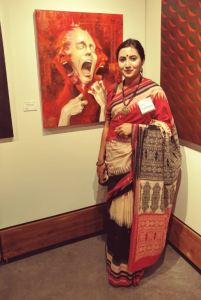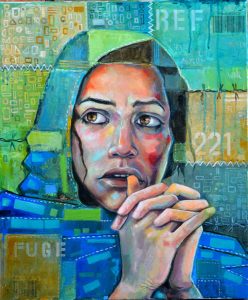Poulami Banerje is a full time independent contemporary and figurative artist who recently had her work shown at this summer’s Sooke Fine Arts exhibition.
She has completed more than 200 commissioned paintings and previously worked in India as a story illustrator, graphic designer and designed the website interface for a Bengali news channel.
What do you hope people will do, see, feel, etc from viewing your work?
Painting is a form of language which helps me to voice my outlook towards certain issues that stir me emotionally. I feel that I have expressed myself to the viewer aptly through my art only when it moves the audience or evokes an emotional response in them. I hope they understand the emotional journey I went through in order to create the artwork. Most importantly, if my art offers them a new experience or idea and inspires them to be more actively involved with the issue, I feel that I have accomplished my responsibilities towards the society as an artist. Moreover, I would be grateful if they feel the same about the cause that drove me to express myself in a particular manner.
Do you see artists as catalysts for change? If so, how?
 I firmly believe that art is a form of ongoing global movement which acts as a mirror to the society, influencing and stimulating them globally towards an objectively better world. Time and again, we have seen evidence how artists have had a strong effect on contemporary social issues, be it the Guernica of Picasso or Banksy’s ‘Les Mis’ Refugee Crisis or the movie “Philadelphia”, they all left an impact on the way people think or live. Art embodies one of the few zones in our culture where societies may unite to share a single experience even if they tend to see the entire world in drastically different manners. Moreover art also inspires us to embrace new ideas and appreciate one’s imagination. Artists tend to breakdown the rules and discover unusual still impactful ways to make people aware of imminent contemporary issues.
I firmly believe that art is a form of ongoing global movement which acts as a mirror to the society, influencing and stimulating them globally towards an objectively better world. Time and again, we have seen evidence how artists have had a strong effect on contemporary social issues, be it the Guernica of Picasso or Banksy’s ‘Les Mis’ Refugee Crisis or the movie “Philadelphia”, they all left an impact on the way people think or live. Art embodies one of the few zones in our culture where societies may unite to share a single experience even if they tend to see the entire world in drastically different manners. Moreover art also inspires us to embrace new ideas and appreciate one’s imagination. Artists tend to breakdown the rules and discover unusual still impactful ways to make people aware of imminent contemporary issues.
What are some of the biggest issues you think we are facing today? How can art and artists help with these issues?
 At the risk of sounding naive, I still dream of a world where “hunger” is unheard of,“war” is a word which is merely confined in history books and “equal rights” is not just an illusion. Current global political trends and widespread evidence of xenophobia, jingoism and ethnocentrism at the core of modern social outlook has greatly obfuscated this dream of mine. I have always had strong reactions to any form of inequality and injustice and I feel my upbringing played an important role in developing such a mindset. Being raised in a progressive family, I was conveniently unaware of gender inequality up to a certain age, which is a glaring problem in India. The protective bubble didn’t last too long and I experienced everything that one should expect from a society where discrimination and intolerance is ubiquitous.
At the risk of sounding naive, I still dream of a world where “hunger” is unheard of,“war” is a word which is merely confined in history books and “equal rights” is not just an illusion. Current global political trends and widespread evidence of xenophobia, jingoism and ethnocentrism at the core of modern social outlook has greatly obfuscated this dream of mine. I have always had strong reactions to any form of inequality and injustice and I feel my upbringing played an important role in developing such a mindset. Being raised in a progressive family, I was conveniently unaware of gender inequality up to a certain age, which is a glaring problem in India. The protective bubble didn’t last too long and I experienced everything that one should expect from a society where discrimination and intolerance is ubiquitous.
These problems seemed slightly less prominent when I moved to the West.
There are so many economical, political and environmental issues in this modern era that it’s hard to identify the biggest one. However I do feel lack of compassion and tolerance in a major section of society is something that is a barrier between us and a better future.
What would be your dream project/assignment?
I already have quite a few ideas that I would like to turn into reality in the near future. These are mostly paintings, installation arts and short films. I am also interested in working with large canvases and larger than life substances, although I never had the logistics to support this idea.
However it’s hard for me to single out one of these projects as my dream project. I wish to contribute to society in my own way through my work for now and I hope that eventually this will lead to something significant.
What is your process in creating a piece which incorporates social commentary? Do you first have a vision and apply the message, or have a message and create the vision?
 Usually ruminating about a subject that originates from a social issue leads me to a creative visualization of an artform which I immediately pen down in my notebook. Later on, standing in front of the blank canvas, the recollections of the idea start to take shape. I usually do not do the pencil sketch first but start painting with my brush, and let my brush flow freely and guide me through the process. I personally do not believe in restricting myself to a certain style of painting. Rather, I let the style to be defined by the idea in a natural way, and in this sense my paintings represent my own identity. For example, recently many of my paintings tend to have faces in them, but I do not consider them to be portraiture. Rather, I envisage their countenance as the political, geophysical and psychological aspects of the current society. I enjoy working with all sorts of mediums, sometimes I like to add variety of textures using heavy paints and spatula. At times, I like to incorporate small objects for recycle in my house into the paintings. After going through this whole process, the final outcome may look quite different from the initial image I had in my mind when I started the painting.
Usually ruminating about a subject that originates from a social issue leads me to a creative visualization of an artform which I immediately pen down in my notebook. Later on, standing in front of the blank canvas, the recollections of the idea start to take shape. I usually do not do the pencil sketch first but start painting with my brush, and let my brush flow freely and guide me through the process. I personally do not believe in restricting myself to a certain style of painting. Rather, I let the style to be defined by the idea in a natural way, and in this sense my paintings represent my own identity. For example, recently many of my paintings tend to have faces in them, but I do not consider them to be portraiture. Rather, I envisage their countenance as the political, geophysical and psychological aspects of the current society. I enjoy working with all sorts of mediums, sometimes I like to add variety of textures using heavy paints and spatula. At times, I like to incorporate small objects for recycle in my house into the paintings. After going through this whole process, the final outcome may look quite different from the initial image I had in my mind when I started the painting.
What inspired you to begin creating the art you make?
Since my childhood, my world was built by the people around me. Being raised in a big city, I have always been fascinated by the myriad of emotions and life stories one can learn simply by meeting and observing new people. I have always been a keen follower of global affairs and how it is affecting the society in various ways. I think all these have played a role in the kind of subjects which inspire me and the kind of art I have been making in recent times.
